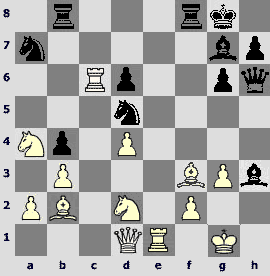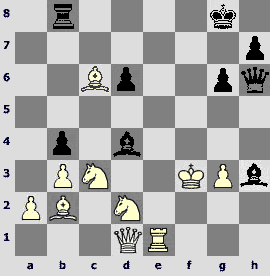07.11.2005
V.BOLOGAN. SWING
One of the biggest Russian publishing houses, "AST", is going to publish the book of V.Bologan "Footsteps" (256 p., 52 games and fragments, autobiography, fragments from author's diary, photos and tournament tables). From Garry Kasparov's preface: "In our computer epoch few of strong chess players think about writing a book. It is a time-consuming work that does not get enough financial compensation from chess professional's point of view. Moreover, to write a book one must have some ideas that make it interesting to wide chess public. That is why I took Viorel Bologan's manuscript with interest. The size of it impressed me, and knowing Viorel, I had no doubts I would find many interesting chess thoughts in it. I think all chess players that want to continue their perfection should read it. The book certainly addresses young chess players first of all. They are sure that all the necessary information concerning chess can be found in the Internet or contemporary chess databases. As a matter of fact, nothing can substitute for printed words, because for perfection one needs to understand what was done before and also be able to adapt this information to one's chess style". We call readers' attention to the excerpt from the chapter called "Swing", where the beginning of the author's professional chess career is described (1992-1996) "The time of falling is long enough The hardest thing in sport is to make oneself work, to discipline oneself. It turned out that despite living in strong intellectual environment, psychologically I was left to myself. I obviously lacked Gata Kamsky's father that would have given me no chance to relax. After the Soviet Union championship I felt the ground slipping away from under my feet, although everything looked rather decent. After the bad play it the New Year tournament in Stavanger (Norway) two failures followed, in India and France. And in Calcutta I lost the last round to the local idol, rising chess star Viswanathan Anand. Turning over the pages of the diary of that time, I paid attention to the notes concerning my psychological condition during the Indian tournament. The end of January, 1992, an abstract from the after-tournament analysis of my play in India: One thing is to write and another one to fulfill. In February the Cappelle la Grande tournament follows, then a short April warming up – sharing the 2nd-5th places together with Kramnik behind Shirov in Oakham (Britain) and absolute failure in the 9th category tournament in Romanian city Calimanesti in May. Stop! Here it was not late to stop and reflect. But unfortunately, competition calendar is often merciless to a player. Just after Calimanesti the Chess Olympiad in Manila followed, brining the loss of 25 rating points. I started fine with 3 wins in 4 games, but then I fell ill – hated air conditioners have done their part. We had no substitutes, so I did not have enough health to play 14 rounds. And then till the tournament in Greece I did nothing but rested. Some work was done of course. Turning over the pages of my diary, I found detailed annotations to Manila games, but there were no conclusions, no clear guiding lines. Nevertheless, the relaxation did me good, and I played nice the first half of my first strong round tournament, and got +2 in six games playing with young talents: Kramnik, Lautier, Adams, Ivan Sokolov, Ulybin, Akopian, Illescas. However, in the end I lacked concentration, and slipped to -1 after 3 losses. V.Bologan-V.Akopian Vladimir Akopian is a person of my age, only one week older than me. He is an example of successful chess career: U-16, U-18, U-20 world champion, and Las Vegas world championship finalist. I also played in the U-20 championship that was held a year before this game. I was on the first place, but then lost to Vladimir. Then I was also defeated by Ulybin, and after that I left the struggle for the first place. And then a year later we met again in Greece in the 14th category tournament. 1.e4 c5 2.¤f3 d6 3.d4. During the youth championship we had 3.Ґb5+, and I got a good position, but made a mistake in a time trouble. 3...cd 4.¤xd4 ¤f6 5.¤c3 a6 6.Ґe3 e6. Black chooses the Scheveningen structure. Now White has several aggressive continuations – 7.f3, transposing to the English attack, 7.g4 with subsequent piece sacrifice (7...е5 8.¤f5 g6 9.g5 gf 10.ef etc.), but in this game I decided to use classic setup with the bishop on е2. 7.Ґe2 Ґe7 8.f4 Јc7 9.0-0 0-0 10.ўh1 ¤c6 11.Јe1 ¤xd4 12.Ґxd4 b5 13.a3 Ґb7 14.Јg3. Tabia. More than half a thousand games can be found in the database for this position. Here the opponent decided to surprise me with a rare move. 14...¦ad8?! It is a rather unsuccessful deviation from the main variations. In case of 14...¦ac8 15.¦ae1 Ґc6 16.Ґe3 Black equalizes the chances with the help of typical operation: 16...e5! 17.fe ¤h5 18.Јh3 de, for example: 19.¤d5 Ґxd5 20.Ґxe5 Јxe5 21.ed Јg5 22.Ґxh7+ ўxh7 23.¦f5 Јxf5 24.Јxf5+ g6 25.Јh3 Ґd6 26.g4 ¦c2. This possibility is mentioned in the monograph of G.Kasparov and A.Nikitin «The Sicilian Scheveningen». 14...Ґc6 is considered to be strongest here, for example: 15.¦ad1 ?ac8 16.¦fe1 ¦fd8 17.Ґf3 ¤e8 18.Јf2 ¦b8 19.¦d2, a draw (Gallagher-A.Sokolov, Besancon 2003). 15.¦ae1 Ґc6 16.Ґd3 Јb7. With a rook on d8 16...e5?! does not work because of 17.fe ¤h5 18.Јf2 de 19.Ґb6 Јd6 20.Ґxd8 Ґxd8 21.¦d1± (Kosteniuk-Shaposhnikov, St Petersburg 2000). 16...¤h5 could also be followed by 17.Јf2. 17.Јh3 g6. I was going to answer 17...h6 by 18.¦e3 b4 19.ab (19.¦g3!?) 19...Јxb4 20.¤e2 with better play. 17...¤e8 18.¦e3 Јd7 19.e5 g6 20.f5 de 21.Ґxe5 Ґf6 22.Ґxf6 ¤xf6 23.fg fg 24.Јxe6 ўg7 25.Јxd7 ¦xd7 26.¦e6 Ґb7 27.ўg1± (Palac-Hulak, Vinkovci 1995). 18.f5. It is very important to maintain the tension that is hard for Black to get rid of. 18...e5. 18...gf 19.Јh6! (19.ef? e5 with an idea of ўh8, ¦g8) 19...e5 20.¦xf5 loses. 19.Ґe3 ¤h5. It was a novelty, but it hardly has any value, because White's advantage is doubtless, for example: 19...¤xe4? 20.¤xe4 Ґxe4 21.Ґxe4 Јxe4 22.Ґh6 Јxc2 23.f6±. An unpleasant answer to 19...¦fe8 is 20.Ґg5, for example: 20...¤d7 21.fg hg 22.¦xf7 ўxf7 23.Јh7+ ўe6 24.Јxg6+ ¤f6 25.¦f1. 20.Ґe2?! It allows exchanging a knight and a dark squared bishop. 20.Ґh6 20...¦fe8 21.Јf3 (21.Ґe2 ¤f4) 21...Ґf6 22.¤d5 Ґxd5 23.ed± is stronger, as it was in the Wang Pin-J.Shahade, Shanghai 2002. 20...¤f4 21.Ґxf4 ef 22.¦xf4. It seems that, having yielded the pawn, Black can sigh with relief: he has two bishops and the control over black squares, where he can fortify his position. Nevertheless, the pawn is the pawn. If we remember the game with Itkis, I attacked there with the same set of pieces on board, but we had equal number of pawns. 22...Ґg5. Maybe Black had to play more modestly, for example 22...Ґf6. 23.¦g4 Јe7 (23...Ґf6 24.¦f1 ўg7) 24.¦f1 Ґf6 25.Ґd3 Јe5. It seems that Black managed to achieve blockading position and impede White's attack. However, as it often happens in my games, at this moment I begin transferring a knight to the main action area. 26.¤e2?! From here the knight can jump to one of three tempting squares – f4, g3 or d4. And still one had to play more solidly – 26.¤d1 ўg7 27.¦g3 Ґxe4 28.¤f2 Ґxd3 29.¤xd3І. 26...ўh8. It is a bit coward; one had to capture the b2-pawn: 26...Јxb2! a) 27.¤f4 Јe5 (27...Ґe5!?) 28.fg (28.¤h5 Ґh8, and there is no decisive continuation for White) 28...hg [28...fg 29.¤e6 Ґd7 30.¤xf8 ¦xf8 (30...ўxf8 31.Јxh7 Ґxg4 32.Јxg6ќ) 31.¦xg6+ hg 32.Јxd7±] 29.¤d5 (29.¦xg6+ fg 30.¤xg6 Ґd7!; 29.¤h5 Ґh8 30.¦f5 Јb2 31.e5 Ґd7 32.¤f6+ Ґxf6 33.ef Ґxf5°) 29...Ґxd5 (29...Ґg7 30.c4 Ґd7 31.Јh4 ¦fe8 32.¦g5±) 30.ed Ґg7=; b) 27.c3 Јxa3 28.¤f4 Јxc3 29.e5 Ґxe5 30.fg fg 31.¦xg6+ hg 32.Јe6+ ¦f7 33.Јxg6+ ¦g7 34.Јe6+ ¦f7=; 28.¤d4 Јxc3 29.fg fg 30.¤e6 Ґd7; 28.¦h4!? Ґxh4 29.Јxh4 d5! 30.¦f4 (30.f6 ¦fe8 31.¦f3) 30...¦fe8 (30...de 31.Јh6 ¦xd3 32.f6 ¦d1 33.¤g1 ¦xg1 34.ўxg1 Јc1 35.ўf2 e3 36.ўg3ќ) 31.e5 Јe7 32.Јh6 Јf8 33.Јh4, and Black can repeat moves – 33...Јe7, or struggle for advantage by 33...¦xe5 34.fg hg 35.Ґxg6 fg 36.¦xf8+ ¦xf8 37.Јg3; 28.e5 de 29.fg fg 30.Ґxg6 hg 31.¦xg6+ Ґg7 32.¦xf8+ ¦xf8 33.¦xc6 ¦f1+ 34.¤g1 ¦xg1+ 35.ўxg1 Јc1+ with equality. 27.c3. After the game Akopian showed me how White could win from the very beginning: 27.fg fg 28.¤f4 ўg8 29.¤e6 Ґd7 30.¤xf8 Ґxg4 31.Јxh7+ ўxf8 32.Јxg6. 27...Ґd7 28.¤d4. The knight has occupied a perfect position in the centre. It is hard for Black to get rid of the tension on the f-file, and he is still a pawn down. 28...¦de8 29.¦gf4 d5?! This move only allows the d3-bishop joining the attack, while hopes to pin the f5-pawn do not come true. Black had to play more solidly – 29...ўg7, although after 30.Ґb1 and the bishop transfer to а2 White gets a great advantage. 30.ed Јxd5. 31.¤e6!? White also had other, more accurate way to the victory: 31.Јh6 (with a threat of 32.fg!) 31...Ґg7 32.Јh4 g5 33.Јxg5 f6 34.Јh4. 31...¦xe6! It is the only move that allows Black to continue resistance. 31...fe? 32.fg or 31...Ґxe6 32.fe Ґg7 33.ef ¦e6 34.¦h4 h5 35.Ґxg6 was losing. 32.fe Ґxe6 33.Јe3. 33.Јf3 was simpler. 33...Ґg7 34.Ґe4 Јd6 35.¦4f2 ¦d8 36.¦e1 ўg8 37.Ґf3 h5 38.¦ff1 Јc7 39.¦d1 ¦xd1 40.¦xd1. White took some pressure off the position by trading rooks. 40...Ґe5 41.g3! White's pawns have to be placed on dark squares to restrict the e5-bishop. In case of 41.h3?! Ґb3 great problems with converting the material advantage could arise. 41...ўg7 (41...h4 42.Јg5! hg 43.¦d8+ ўg7 44.Јh4) 42.¦e1 Ґf6 43.Јe4 Јc5 44.ўg2 a5 45.¦d1 Ґc4 46.¦d2 Ґe6 47.¦d1 Ґc4. The move repetition is just a simple trick that underlines strength of White's position. 48.¦d7 b4. 48...Јc8 49.¦d6 with subsequent Јf4 ended the f6-bishop era. 49.ab ab 50.cb Јc8. 50...Јxb4? 51.Ґe2 Јa4 (51...Јb5 52.¦xf7+!!) 52.¦d4!. It is simple but beautiful. 51.¦d2 Ґb5 52.¦c2 Јa6 53.Ґe2 Ґxe2 54.¦xe2 h4 55.g4 Јd6 56.g5 h3+ 57.ўf3. Black resigned. Lessons: 1) If one decides to apply a novelty in a well known position, then it has to be well analyzed and thought-out, because deviating usually means trouble. It happened so in this game, after 14...¦ad8 White got a long-lasting initiative. 2) 20...¤f4 is a typical tool, a pawn sacrifice for controlling dark squares. The e7-bishop goes to f6, and its influence sharply increases. 3) In situations when the play is very sharp, the most concrete approach is required. If one plays according to general considerations (26...ўh8), one has a chance not to save the game. One has to calculate the most principled variations till the end, because sometimes the course of the game makes one choose more sharp continuations. In contemporary chess the classic "trainer-pupil" scheme is almost absent; it remained maybe for the very young chess players. Instead the cooperation of strong chess players, so-called seconding, and sometimes sparring partnership became widespread. My debut as a second took its place in the autumn of 1992, when Alexei Shirov invited me to help him during the Tilburg tournament. At some moment friendly relationships developed into a fruitful cooperation. We worked on chess together and were sparring partners. In those cases when I seconded him during tournaments, Alexei was generous and my work was well paid. A.Shirov and V.Bologan If we digress a little and talk about seconding, the main function of a helper from my point of view is psychological support. A high class grandmaster plays what he knows; it is hard to learn something new during the tournament with the second's help. Of course, occasional tip might be useful, but the most important thing that the helper should be able to do is to create necessary atmosphere, help the player to recover after a difficult game, support him. When I worked with Shirov, there was no such informatization and computerization of chess. Yes, I shared Chebanenko's ideas with him, we discussed Lanka's schemes, invented something ourselves, but generally speaking there was no intensive opening preparation. However, while working with me, Shirov almost avoided defeats in high-level games. Of course, he had achieved that thanks to his talent first of all. Our fruitful cooperation lasted till 1996. Although we did not meet very often (I continued my career nevertheless), I joined him for the main tournaments. Running ahead, I will say that I acted as second again in 2002; Ruslan Ponomariov invited me to help him during the Linares tournament. The situation was somehow like the aforementioned one, although the initial stimulus was not friendship, but Ruslan's sponsors' proposal to participate in the training session at their expense. In Linares Ruslan took the second place, and it was one of the best achievements in his career but for the victory in the world championship of course. I would not say that I helped Ruslan greatly with his openings. The second just has to be a good psychologist; I mean not a professional one but a person that produces kind and positive emotions. For me the wife has always been the prefect second. So, in Dortmund-2003 the majority of players had strong grandmasters as helpers. For example, Rustem Dautov helped Anand, Arshak Petrosian seconded Leko, and I came with Margarita and won the tournament. This proves the fact that psychological factor is on the most important for chess players. Coming back to the 1990s that were wild in all respects, I should mention that, despite becoming a chess helper on my own will, I still preserved my sporting ambitions in full measure. But ambitions themselves are not enough. Unfortunately, I could not state sporting task for myself more clearly. I rather followed general considerations. I supposed that going with Shirov to Linares or Tilburg would be useful for me anyway, because I would have a chance to work with a great player. I really found out a lot of interesting new things, but this work did not increase my practical strength. I earned enough, but while you do not have family, money is not of great significance. Anyway, I do not regret this work. * * * In the spring of 1993 before graduating from the university I faced the question where to live and what to do. The decision came from overseas all of a sudden, but I will tell about it a bit later. I got to my first New York Open with many adventures. During the check-in I was the only one in the group consisting of former Soviet Union chess players who was not allowed to board the plane. It turned out that only Moldavians had to get transit Irish visa (in those times planes from Moscow to America flew via Shannon). I had to wriggle out of it, and after 24 hours of struggles with Aeroflot and Irish embassy I managed to board the plane and come to the tournament several hours before the start. I played in America for the first time. I felt as if I arrived to the other planet. People are the same, houses are made of stone, cars have wheels, but I still cannot get accustomed to American life rhythm. Maxim Dlugy was the junior world champion, and then he became a businessman and succeeded in his new field. Then we made friends with him, and for some time I even worked in the Moscow representative office of his company, and this game was the starting point of our acquaintance. 1.d4 d5 2.c4 c6 3.¤c3 ¤f6 4.e3 a6. The Chebanenko variation of the Slav defense. Its pure form arises in case of 4.¤f3 instead of 4.е3. Black has rich possibilities here: the а6-pawn restricts the с3-knight; the play with b7-b5 becomes possible either immediately or after the exchange on с4. This obviously prophylactic and waiting move makes White chose one of nine possible moves and plans. Chebanenko had decent original answers to them all. By the way, no refutation of it is found so far. I do not know any other variation suggested by a non-professional chess player that would have remained not refuted that long. 5.¤f3 b5 6.b3. This continuation still occurs in tournament practice. 6...Ґg4. 6...Ґf5 7.Ґd3 e6 8.Ґxf5 ef 9.0-0 Ґd6 10.Јd3 g6 11.a4 dc 12.bc b4 13.¤e2 ¤bd7 14.Ґb2 0-0 15.¦fd1 Јe7› (Kasimdzhanov-Sakaev, Bundesliga 2003). 7.h3. 7.Ґe2 is considered more popular nowadays. 7...Ґxf3 8.Јxf3. Nowadays White usually connects 7.h3 with the pawn capture, for example: 8.gf ¤bd7 9.f4 e6 10.c5 ¤e4 11.¤xe4 de 12.Ґg2 f5 13.f3 ef 14.Ґxf3 ¦c8 15.Јe2 with White's advantage (Vallejo-I.Sokolov, Selfoss 2003). 8...e5!? This variation was worked out by Vyacheslav Andreevich about 30 years ago. And of course it was unexpected for Dlugy. Possibly, the more precise version is the preliminary exchange on c4 by 8...bc. 9.de Ґb4 10.Ґd2 Ґxc3. In case of 10...¤e4 11.¤xe4 de 12.Јd1 Јxd2+ 13.Јxd2 Ґxd2+ 14.ўxd2 ўe7 15.ўc3 White's chances are still better. 11.Ґxc3 ¤e4 12.Ґb4 bc 13.bc. In contrast to the variation with 8...bc, White gets additional possibilities, for example: 13.e6!? ¦a7 14.bc c5 15.cd Јxd5 16.¦d1 Јxe6 17.Ґa3 ¤d7 (17...0-0 18.Ґd3 ¤c3 19.Јh5 f5 20.¦c1 Јxa2 21.¦xc3 Јa1 22.ўd2 Јxh1 23.Ґxc5ќ Gasanov-Deviatkin, Voronezh 2003) 18.Ґd3 ¤df6; 13.Јg4!? c5 14.Јxg7 ¦f8 15.¦d1 Јb6 16.Ґd2 c3 17.Ґc1 c2 18.¦d3 c4 (Hillarp Persson-Ibragimov, Scelleftea 1999). 13...Јb6 14.a3 a5. The bishop leaves an important diagonal. 15.cd cd (15...ab 16.Јxe4 ¦xa3 17.¦b1) 16.Ґd2! (16.Ґc4 Јc6; 16.Ґd6 Јb2 17.¦d1 Јc3 18.ўe2 ¤d7 19.¦xd5 Јc4 20.¦d3 ¦c8 Poluljahov-Moskalenko, Rostov 1993) 16...Јb2. 16...¤xd2?! 17.Јxd5 ¤xf1 18.Јxa8 0-0 (18...¤xe3 19.fe Јxe3+ 20.ўf1 Јd3+ 21.ўf2 Јd4+ 22.ўg3 Јxe5+ with a draw) 19.Јe4 ¤d2! 20.Јc2 ¤b3 21.¦b1 a4 22.0-0 ¤a6 23.Јc4 ¤ac5 24.¦fd1›. 17.¦d1 ¤c6 18.a4?! White wants to strengthen the bishop on b5, but it was far more important to finish the development right away: 18.Ґd3 ¤xe5 19.Јe2 0-0 20.0-0 Јxa3 21.Ґxe4 de 22.Јb5! and ¦a1=. 18...0-0 19.Ґd3 ¤xe5 20.Јe2 Јa2 21.Ґxe4 (21.0-0 ¤xd2 22.¦xd2 Јxa4µ) 21...de 22.Ґc3?! (22.0-0 Јxa4µ or 22...¦fd8µ) 22...¤d3+ 23.ўf1. White is again without a chance to castle in a difficult position. 23.¦xd3 Јxe2+ 24.ўxe2 ed+ 25.ўxd3 ¦fb8µ is better. 23...Јxa4 24.¦a1 Јc4 25.Ґd4 a4 26.ўg1 f5 27.ўh2 Јc7+ 28.g3 ¦fc8 29.¦a3 Јc2 30.¦a2 Јxe2 31.¦xe2 a3 32.g4 fg 33.hg ¤c1. It was more simple to play 33...¦c1 34.¦xc1 ¤xc1 35.¦c2 ¤b3 36.Ґe5 a2 37.¦c7 g6! (or 37...a1Ј 38.¦xg7 ўh8 39.¦e7 Јxe5 40.¦xe5 ¤d2°) 38.¦g7 ўf8 39.¦xh7 a1Ј 40.Ґxa1 ¦xa1 41.ўg3 g5! 34.¦ee1 ¤b3 35.¦e2 ¦c1 36.¦xc1 ¤xc1 37.¦c2 ¤b3 38.Ґe5 ¦a7? By 38...a2 one could go on to the variation analyzed in the annotation to the 33rd Black's move. 39.¦a2 ¤c1 40.¦a1 ¤d3 41.Ґd4 ¦a4 42.¦a2! ўf7 43.ўg3 g6 44.¦c2 ўe6 45.¦c7 a2 46.Ґa1 ўd5 47.¦xh7 ¤c5 48.ўf4 ¤b3 49.¦h1 ¤xa1 50.¦xa1 ¦a6 51.g5 ¦a4 52.¦d1+ ўe6 53.¦a1. The triangulation provides Black with the victory. 53...ўd6! 54.¦d1+ ўe7! 55.¦a1 ўe6 56.ўg4 ўe5 57.f4+ ef+ 58.ўxf3 ўf5 59.ўe2 ўxg5 60.ўd3 ўf5. White resigned. Lessons: 1) Sometimes non-standard solutions in the opening allow imposing a non-typical play on the opponent, the initiative playing an important role in it. With White having an advantage of two bishops, Black has taken higher obligations and had to develop the opening initiative quickly. 2) Non-castled king always increases the degree of risk, especially when opponent's pieces are dangerously close to it. 3) During the realization of the advantage one has to preserve concentration of attention and calculate the concrete variations accurately. If one continues to play guided by general considerations, the advantage can be vanished. During the tournament my friend Dina Tulman advised me to become a student of Mark Izrailevich Dvoretsky for a start. I do not know whether her recommendation turned out to be so good or Dvoretsky decided that something would come out of me, but he became my teacher. My results improved. I gained 100 rating points in a year. At the same time my tactical vision sharpened. To prove it I will cite an episode of my first tournament in Biel. R.Skomorokhin-V.Bologan White captured the f6-pawn with the last move, threatening a classic discovered check. 28...¤d3! Black has an extra pawn, and he is ready to sacrifice the knight on e5 to block the dangerous diagonal. 28...ўg7 29.¤g4+! (29.¤h5+? ўf7 30.Јg7+ ўe6°) 29...ўf8 30.¤h6! Јe6 31.Јh8+ ўe7 32.Јg7+ ўe8 33.Ґh3! Јe7 34.Јg8+ Јf8 35.Јe6+ Јe7= is weaker. 29.Ґe4 (29.¤g4+ ¤e5 30.fe Јxg4 31.ed+ ўg8 32.Јf6 ¦d7°) 29...¤xf4! Black uses tactic motif again: the fork on e2 threatens. The struggle for the key square e5 goes on. 29...Јe6 30.Ґxd3 Јe7 31.g4 with an idea of g5 is weaker. 30.¤g4+ (30.Ґxf5 ¤e2+; 30.gf Јxf4 31.¤g4+ ўg8) 30...Јe5. Here the combination ends, and White has to proceed to the endgame without a figure. 31.¤xe5 ¤e2+ 32.ўg2 ¤xc3 33.¤f7+ ўg7 34.¤xd8 ¤xe4 35.¤xb7 ўf6 36.¤xa5 c5, and gradually I managed to convert an extra piece. Dvoretsky, who is gifted by the nature not only with chess talent but also with remarkable capacity for work, managed to create his own system of working under specified chess skills. Using to his method, one can improve skills in any component of chess mastery: positional play, tactical vision, prophylaxis, calculation. In comparison with Chebanenko and Lanka, his lessons were absolutely different. Mainly I solved problems: you learn the theory and start training in solving problems, playing certain positions. So, by becoming Dvoretsky's student, I followed Chebanenko's instructions four years late. V.Bologan, V.Zvjaginsev and M.Dvoretsky The lessons with Dvoretsky influenced my decision to stay in Moscow. And as I almost had not studied for two last years at the university, and I always had a constant thirst for knowledge, I decided to bridge the gap, and entered a post-graduate study. During the first year I visited a majority of lectures, although I took active part in the competitions. We had an excellent philosophy course. Every post-graduate student had to prepare the report on a topic interesting to him, and then the discussion followed. There were reports on Christianity (my topic), Buddhism, ancient philosophers, existentialism etc. We also had lections on esoterics. Now nobody is amazed by astral or Buddhism, and in those times it was something new. Having become a post-graduate, I decided to come back to the dormitory, where I had a separate room that I had got for the previous public work as a head of the students social services committee. First of all I had to exterminate cockroaches that in the time of previous owners used to run behind the wall paper and to rustle so loudly that it was impossible to sleep. There were tons of garbage there! After my clean-up, the metamorphosis misled students when they visited me. They thought they just opened a wrong door. In the autumn of 1993 before the tournaments in Ostrava and Gran Canaria, Dvoretsky told me not to get into time trouble. During the game I had an anti-Zeitnot time record, the point of which was not only to fix the time spent on every move, but also to spend not more than 50 minutes on first 20 moves, to leave at least 3 minutes for every move, and to follow this schedule even if it damages the quality of games. I fulfilled it as an obedient pupil, and you know it helped! I won both tournaments, and at Canaries I began with 8 out of 8 and made a quick draw only in the last game. Ostrava was almost the first tournament where our cooperation with Dvoretsky really started to pay off. S.Guliev-V.Bologan Ostrava (Czechia) 1993 Sarhan Guliev is an interesting and original grandmaster who was a leader of the Azerbaijan team at first at the USSR Spartakiads and then at the Chess Olympiad. The last White's was capturing the c6-pawn with the rook, and now the knight on d5 hangs. And here the «carrousel» begins. 23...¤c3! 24.¤xc3. After 24.¦xc3 bc 25.Ґxc3 (25.¤xc3 Ґxd4 26.¤de4 Јg7!) 25...¤b5 26.¤e4 Black gets an advantage. 24...¤xc6 25.Ґxc6 ¦xf2!! A sudden although a rather typical blow; by the way, it is an intermediate move also. Now the d2-knight hangs, and there is an eventual threat of Ґg4, so White has to take the rook away and go to the center with his king. 26.ўxf2. Or 26.¤ce4 ¦g2+ 27.ўh1 ¦xg3 28.¤xg3 Ґg4+ 29.ўg1 Ґxd1 30.¦xd1 Јe3+ 31.ўg2 Ґxd4 32.Ґxd4 Јxd4; 26.¦e2 bc 27.¦xf2 cb. 26...Ґxd4+ 27.ўf3. 27...Ґg4+! 28.ўe4. One could get mated in the centre of the board: 28.ўxg4 Јh5+ 29.ўf4 Јf5#. 28...Ґxd1 29.¤xd1 Ґxb2 30.¤c4 Јg5 31.¤de3 Јxg3 32.¦f1 ¦f8 33.Ґd5+ ўg7. White resigned. In the second year of post-graduate studies in the autumn of 1994 I finally moved to a flat in Strogino. This district is situated in the northwestern Moscow, opposite to the famous Serebryany Bor; the district is surrounded by parks. It is one of a few places in Moscow where you are allowed to swim in the Moscow River. Shortly speaking, it is a resort in a megapolis. But the main motive was becoming Dvoretsky's neighbor. I rented the flat from his acquaintances. One can swim in summer, jog in autumn and in spring, and go skiing in winter, «Sheremetyevo-2» international airport is in 20 minutes ride. What else is necessary for a chess player? Goals! I lacked this elementary requirement of any chess professional for a long time. I dove in a sharp pique that autumn, and entered yet another chess recession. It all began when I went to play in the Romanian League with severe cold. It was extremely "professional"! The loss of 40 rating points turned out to be rather painful, and it took me two long years to come back to the 2600 level.
to live the whole life".
Alexander Zinoviev
"Psychology – getting a fee (for the first time that big) adversely affected me, a conflict with organizers who did not want to fulfill their financial obligations also had a bad effect. In the beginning of the tournament I could not make myself normalize my schedule, I permanently tried to win back (instead of following Lanka's maxim "just to play chess")"...
Chalkidiki (Greece) 1992
Sicilian defense B85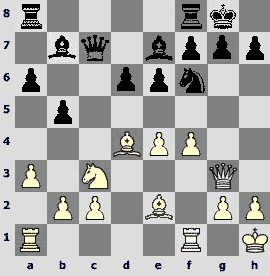
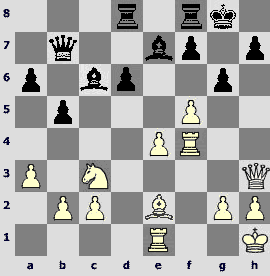
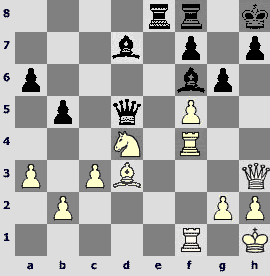
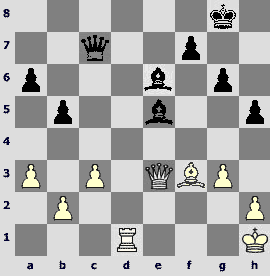
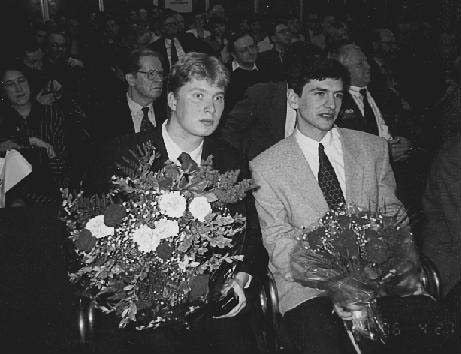
M.Dlugy-V.Bologan
New York (USA) 1993
Slav defense D15


Biel (Switzerland) 1993

